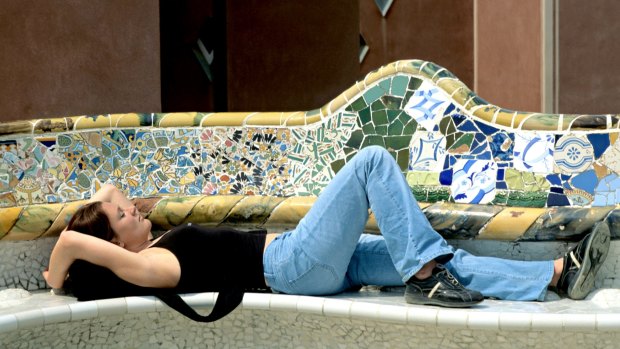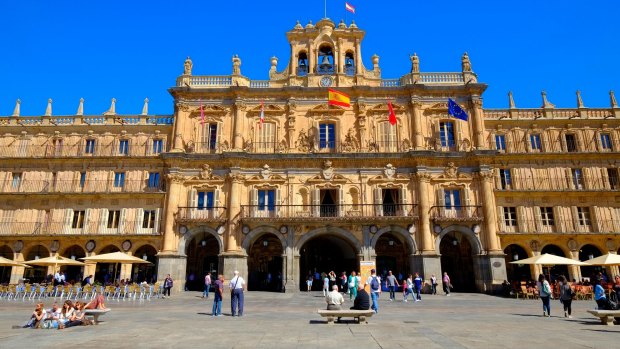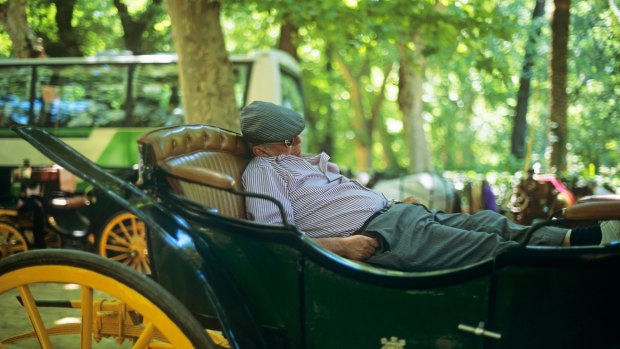By Sue Williams

Taking an afternoon nap in Spain may soon be officially phased out.Credit: Alamy
Spain is a country living in fear ... of losing its siesta.
The authorities have signalled it may be time for the country – with so little money and so much unemployment – to abandon the habit of shutting up shops, bars and many tourist attractions from 2pm to 4pm for the traditional afternoon nap.
"It's absolutely crazy that this still goes on," says exasperated Australian tourist Naomi Holdsworth, 45, as she is turned away from the door of a closing clothes shop in Salamanca in north-western Spain at 1.55pm on a Thursday. "We've got money and we want to spend it, and it's not like they don't need it!

Plaza Mayor in Salamanca, Spain. Credit: imac / Alamy Stock Photo
"But to close up every afternoon … no wonder the country's so broke!"
It's a familiar cry from visitors to Spain, from the ancient city of Salamanca to the major metropolis of Madrid, from the medieval town of Avila to the beaches of Malaga. While some find the persistence of the habit of a daily siesta charming and colourfully quaint, many others find it a downright inconvenience.
For as well as ushering in a post-lunch lull, it also engenders a late start every morning, with few shops opening before 10am or 10.30am, and abominably late evenings, with most locals only going out to dine after 10pm.

Taking a siesta in a carriage in Seville, Spain.Credit: Michelle Chaplow / Alamy Stock Photo
Spotting tourists among the crowds on the streets and in the restaurants at that time is easy sport; they're the ones with eyes bloodshot from the effort of staying awake after a full day's sight-seeing, shuffling along like the walking dead. But finally there is hope in sight. Spanish Prime Minister Mariano Rajoy is again talking about abandoning the two-hour siesta and, without it, ending the normal working day earlier, at 6pm or 7pm. That means Spaniards would eat earlier, put their kids to sleep at a reasonable time and go to bed themselves before midnight … which might also help arrest the dismal Spanish birth rate of 1.32 children per woman, compared to the 1.58 average for the rest of Europe.
For tourists too, it would mean a welcome respite from many of the irritations of travelling in Spain. In Salamanca, the gorgeous city 200 kilometres west of Madrid founded in the early 13th century and glowing softly gold in the afternoon from all the Villamayor stone, the streets of the old city are almost empty as everyone goes for lunch and their daily siesta. Shutters are being pulled down over all the shop doorways, and clusters of visitors are left staring morosely into the windows at keepsakes, clothes and goods they'd love to buy if only …
This city was part of the Romans' silver road with a bridge and statue of a bull – now headless – over on one side erected about 500BC, with the Muslims coming in the 11th century to build on their foundations. Chief among the attractions is the grand university – its construction began in 1134 and is today still a fabulously ornate set of buildings housing 50,000 students.
Christopher Columbus studied here and, at the end of exams each year, there was a bullfight, with students scrawling their names in blood on the walls – of which there are still the faint stains. But while the city was originally built on commerce, today it's its history that keeps it going. Commerce today? Only between 10.30am and 2pm, and 4pm to 10pm. The city's symbol is the lucky frog which was carved above a doorway of the university probably about 1592, and every store has stacks of froggy memorabilia … when they're open.
But most tourists who aren't staying in the city after 5pm end up leaving empty-handed. Locals, however, are still largely resisting any idea of change. Lottery ticket seller Miguel, working on the Salamanca streets, is adamant.
"We have our lunch at home and then have a nap," he says. "It gives us the energy to keep going until night-time. Without it, it wouldn't be Spain anymore."
In Segovia, the home of the last Gothic cathedral to be built in Spain, linen shopkeeper Enriquo is equally unyielding.
"Yes I probably miss a lot of sales," he says. "But money is not everything. La Siesta is tradition. It is part of who we are. We do not want to lose it."
While it's mostly family businesses that still keep to the custom, thought to date back to the Spanish Civil War in the 1930s when poverty forced many to have more than one job so they needed a sleep in the hottest part of the day, even in Madrid, the habit is jealously guarded.
Madrid tour guide Elena says, "We love our siestas. We are Spanish. We need them. We are used to having them every day, especially when it's hot in the afternoons in summer. It's a huge part of our Spanish culture."
But there are others arguing that Spain – and its visitors – would benefit hugely from a shift in both the culture and physical time. After all, Spain, geographically, should really be in the same time zone as Portugal and England, but is instead aligned with German clocks, a hangover from the old Franco-Hitler alliance. As a result, Spaniards tend to work much longer days overall than everyone else – to make up for that two-hour siesta time out – and then sleep around 53 minutes less than the European average. Spain's Employment Minister Fatima Banez has argued that it also has a negative effect on the country's productivity, and could well play a role in its 21 per cent unemployment rate.
With debate on the topic raging internally, many visitors to the country believe a potential end to siesta time would be a definite plus.
"Spain is a fabulous place and there's so much to see," says British visitor Kath Hurley, 53, who's touring the north of the country.
"And the food is absolutely fantastic. But to be honest, I just can't cope with going out to eat at 10pm and then going to bed on a full stomach at midnight. I can't sleep. Then it's hard to get up in the morning in time to start the next round of sightseeing. If this country is serious about wanting to increase tourism, then it's got to align itself more with the rest of the world."
TRIP NOTES
MORE
TOUR
Bunnik Tours' small-group 26-day tour of Spain, Portugal and Morocco visits Madrid, Grenada, Valencia, Barcelona, Seville, Salamanca, Avila and Segovia in Spain. The tour starts from $10,595, including flights from Australia. Phone 1 800 286 645. See bunniktours.com.au
Sue Williams was a guest of Bunnik Tours.
IF YOU CAN'T BEAT 'EM, JOIN 'EM – HOW TO SIESTA LIKE A LOCAL
EAT WELL Have a very big lunch; make it your main meal of the day. If you can, eat it in company, with friends or family.
SLOW DOWN Sit for half an hour to let the digestive process start, then prepare a comfortable, dark place for your siesta.
LOOSEN UP Loosen your clothing or take it off and put on sleepwear to make it official.
SHUT DOWN Turn off your phone and set your alarm for 30 minutes to an hour, whichever you prefer.
START SLOWLY When you wake up, get up slowly and have a shower before venturing back out into the world.
Sign up for the Traveller Deals newsletter
Get exclusive travel deals delivered straight to your inbox. Sign up now.